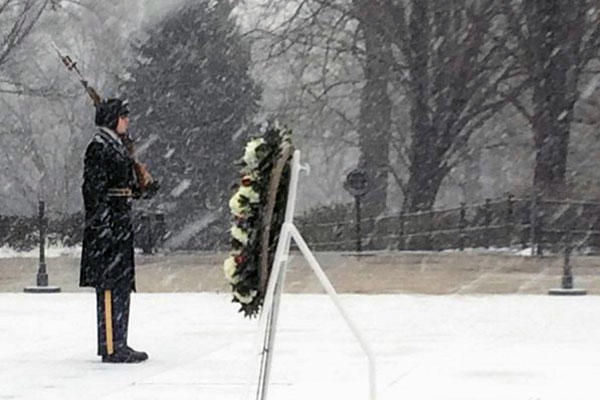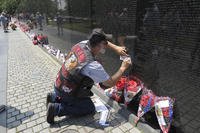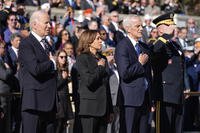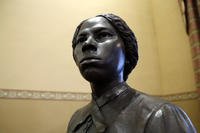In November 1921, the remains of an American soldier who died during World War I in France were brought back home and laid to rest in a somber ceremony at Arlington National Cemetery. The tomb, situated atop a hill overlooking the U.S. capital, is now the cemetery's most iconic memorial.
These words are inscribed on the Tomb of the Unknown Soldier: "Here rests in honored glory an American Soldier, Known but to God."
The tomb is now the resting place of three unidentified U.S. service members. More broadly, it represents all missing and unknown service members who made the ultimate sacrifice. Through its more than 100 years of existence, it has offered comfort for many who lost loved ones whose remains are missing or interred in foreign lands.
The tomb symbolizes those Americans who gave their lives in World War I, World War II and the Korean War in defense of the nation's integrity, honor and tranquility.
Creation of the Tomb
After WWI ended, Great Britain and France created memorials to honor unknown soldiers who lost their lives. In 1921, the U.S. Congress followed suit, acting to create the Tomb of the Unknown Soldier as a symbol of honor and respect for service members, even if their sacrifice meant they will lie forever unknown.
The push was spearheaded by U.S. Rep. Hamilton Fish Jr., a WWI veteran from New York. He "introduced legislation in December 1920 for an American unknown soldier to be interred in a new tomb," according to Arlington National Cemetery. "This Unknown would represent the nearly 2,000 unidentified American soldiers buried in Europe."
Who Is Buried at the Tomb?
Four sets of unknown remains were exhumed from the American cemeteries at Aisne-Marne, Meuse-Argonne, St. Mihiel and Somme in October 1921. They were placed in identical caskets and taken to the city hall in what was then known as Châlons-sur-Marne, France.
There, Sgt. Edward F. Younger, a decorated American soldier selected at random, chose the casket to be sent back home. Younger chose the Unknown Soldier by placing a spray of white roses on one of the caskets. The three others were buried in the Meuse-Argonne American Cemetery.
The casket and remains were transported to the U.S. aboard the storied ship USS Olympia, arriving in Washington's Navy Yard on Nov. 9, 1921, as the Olympia fired its guns in salute. The Unknown Soldier lay in state in the U.S. Capitol Rotunda until Armistice Day, Nov. 11, 1921.
He was then transferred to the Tomb of the Unknown Soldier and interred in a state funeral at Arlington National Cemetery's new Memorial Amphitheater.
"We know not whence he came, but only that his death marks him with the everlasting glory of an American dying for his country," said President Warren G. Harding, who officiated the ceremony. Harding then placed the Medal of Honor, the nation's highest military decoration, on the casket.
Read More: The Story Behind the Tomb of the Unknown Soldier
WWI Unknowns
The remains of the chosen WWI unknown soldier lie beneath the sarcophagus, a monumental stone coffin that was added in 1932, replacing the original simple marble slab.
The U.S. military suffered more than 116,000 service member casualties during WWI. Repatriation of the dead was a significant issue, the scale of which the United States had never before experienced. About 2% of those who lost their lives in WWI, or 1,644 U.S. service members, were never able to be identified.
WWII and Korean War Unknowns
Laid to rest in crypts in front of the Tomb of the Unknown Soldier sarcophagus are three unidentified sets of remains of troops killed during World War II and the Korean War. The WWII and Korean War unknowns were placed there in 1958.
World War II claimed the lives of more than 403,000 U.S. service members, about 10,000 of whom were never identified. The WWII unknown soldier was chosen by Navy Hospital Corpsman 1st Class William R. Charette, who placed a wreath of carnations on one of two identical caskets. One set of remains was from the Pacific Theater, and one from Europe. A burial at sea ceremony was performed for the other unknown soldier.
After the Korean conflict, which left a toll of more than 54,000 U.S. troops, including 925 unknowns, the U.S. Army chose four unknown Americans who were disinterred from the National Cemetery of the Pacific in Hawaii. Master Sgt. Ned Lyle made the selection from the four caskets.
Vietnam War Unknowns
Although the U.S. death toll from the Vietnam War was comparable to that of the Korean War, due to scientific advances, there are no longer any unidentified U.S. remains from the Vietnam War, although more than 1,500 Americans remain unaccounted for.
Air Force 1st Lt. Michael Joseph Blassie, a pilot shot down in 1972, had been the Vietnam War unknown soldier. His remains were added to the tomb in 1984.
However, several years later in 1998, Blassie's remains were exhumed. Scientists performed advanced DNA testing on them, revealing his identity. Following the wishes of his family, Blassie was reinterred in his home state, in a marked grave at Jefferson Barracks National Cemetery in St. Louis, Missouri.
His former crypt at Arlington remains empty, but on National POW/MIA Recognition Day in September 1999, it was rededicated to honor all missing U.S. service members from the Vietnam War.
Tomb of the Unknown Soldier Guards
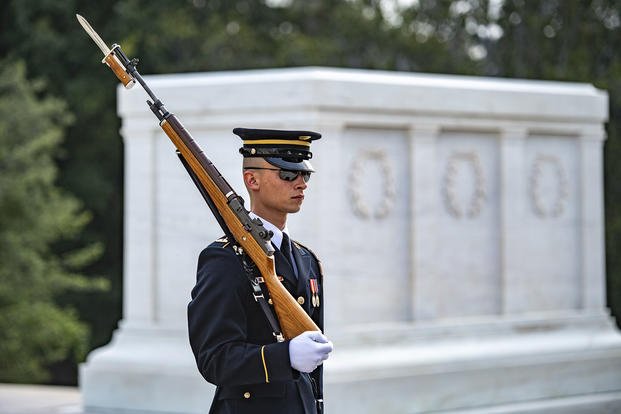
The tomb guards, or Sentinels, are soldiers from the 3rd U.S. Infantry Regiment, also known as "The Old Guard." This regiment has had the honor of guarding the tomb since 1948.
Each Sentinel, who must study and practice extensively before taking a watch position, performs a specific ritual involving sets of 21 steps, sharp movements of his or her M14 rifle, and more, while wearing an Army dress blue uniform.
The changing of the guard ceremony, which lasts only minutes, can take several months of preparation. During the solemn ceremony, spectators are asked to stand and remain silent.
Read More: The Changing of the Guard
Why Is the Tomb Guarded?
The tomb is guarded to protect the dignity of the space.
Although the tomb was created in 1921, a daily watch did not begin until 1925, beginning with a civilian guard. This was in response to reports of disrespectful behavior at the tomb. Some visitors would climb on top of the tomb or leave trash behind. A fence was erected as a temporary solution.
In 1926, a military guard took over, at least during the daytime. The original military guard was from the Washington Provisional Brigade, a forerunner of the U.S. Army Military District of Washington.
Is the Tomb Guarded 24 Hours a Day?
Yes, the tomb is guarded around the clock, and it has been since 1937, no matter the weather. Over the years, railings were also added to keep crowds at a distance.
3rd U.S. Infantry Regiment, or The Old Guard
In 1948, the Army's 3rd U.S. Infantry Regiment, aka "The Old Guard," took over guard duty for the tomb. The regiment, based nearby, in Fort Myer, Virginia, has served the U.S. since 1784 and is the oldest active-duty infantry unit in the Army.
Read More: 3rd U.S. Infantry Regiment (The Old Guard)
To be selected as a tomb Sentinel is considered a high honor. Each guard must undergo demanding training and pass a series of challenging examinations.
Guards also "must be in superb physical condition, possess an unblemished military record and be between 5 feet, 10 inches and 6 feet, 4 inches tall for men or 5 feet, 8 inches and 6 feet, 2 inches tall for women, with a proportionate weight and build."
Guards also must memorize, and be able to cite verbatim, seven pages of Arlington National Cemetery history, as well as know the grave locations of nearly 300 veterans.
Even after all this, guards remain on probation for nine months.
Wreath Laying at the Tomb of the Unknown Soldier
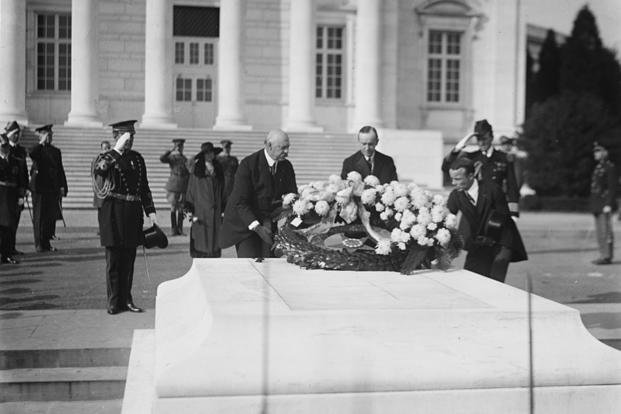
Numerous ceremonies are performed annually at the tomb to honor the unknown soldiers and to show the nation's respect for members of the United States armed forces.
The most notable are wreath-laying ceremonies on national holidays such as Veterans Day or Memorial Day, during which the president or his designee lays a wreath to mark the national observance. Wreath-laying ceremonies also take place during state visits. At these ceremonies, the visiting head of state will pay formal respects to the sacrifice of America's veterans in foreign wars by placing a wreath before the tomb.
All ceremonies performed at the Tomb of the Unknown Soldier, with the exception of Tomb Guard duty performed by the Army Honor Guard, are Joint Service functions led by the Military District of Washington.
During these ceremonies, each service of the armed forces (Army, Marine Corps, Navy, Air Force and Coast Guard) provide Ceremonial Honor Guard personnel to represent their respective service.
Tomb of the Unknown Soldier Facts
- If you visit the tomb, you will be asked to stand during the changing of the guard, but otherwise you may sit.
- Where exactly to place the Tomb of the Unknown Soldier was a matter of debate in Congress. Other ideas were the U.S. Capitol Rotunda, or even a tomb in every state.
- The cruiser that transported the Unknown Soldier's casket to the United States, the USS Olympia, was Commodore George Dewey's historic flagship from the Battle of Manila Bay during the Spanish-American War (1898).
- About 90,000 visitors came to honor the Unknown Soldier over a two-day period in November 1921 when his remains lay in state at the Capitol Rotunda.
- The tomb's dedication event, which included a two-minute moment of silence, was broadcast to New York, Chicago and San Francisco over long-distance telephone wires.
- The decision to hold the Unknown Soldier's funeral on Armistice Day rather than Memorial Day solidified the importance of Nov. 11, now called Veterans Day.
- A few years after the temporary granite tomb was created, a design competition was held for the creation of the permanent memorial, a neoclassical structure that was completed in 1932. The winning design, out of 73 submitted, was by architect Lorimer Rich and sculptor Thomas Hudson Jones, both WWI veterans.
- The monument that makes the sarcophagus was cut out of Colorado marble, and its main section was at the time the largest single piece of marble ever quarried in the U.S., originally weighing 55 tons.
- The three figures carved into the monument depict Victory, holding a palm branch; Valor, holding a sword; and Peace, holding a dove.
- Along with the Tomb of the Unknown Soldier, Arlington National Cemetery is home to the Tomb of the Civil War Unknowns. The collective crypt and monument contains the partial and commingled remains of 2,111 unknown soldiers, mostly found in and around the fields of Manassas, Virginia (Bull Run).
- The number 21, which symbolizes honor in the military (as in the 21-gun salute), is reflected in tomb guard rituals: "The Guard marches 21 steps down the black mat behind the Tomb, turns and faces east for 21 seconds, turns and faces north for 21 seconds, and then takes 21 steps down the mat," according Arlington National Cemetery's description of its tomb guard routine.
Miriam Felt's Letter
In the following letter, Miriam ("Mimi") Felt describes the gravity of the first ceremony for the Tomb of the Unknown Soldier in Arlington National Cemetery in November 1921. She was 23 and employed by the water sanitation division of the U.S. Health Service in Washington, D.C.
Sunday (Nov. 13, 1921)
Dear Family,
Well, this last week has been quite an event in history, and I certainly do wish you all could have been in Washington. It certainly is something I shall never forget. Somehow, you can talk about it and think about it, but the realization of the whole thing struck me so much more by seeing it all, and it was so impressive. Of course, Washington is alive with foreigners of all sorts, and I am turning around all the time to see something else for fear I will miss something. The crowds have been simply enormous, and I feel considerably thinner from having wedged my way through. But leave it to Clara, we are always on the front line.
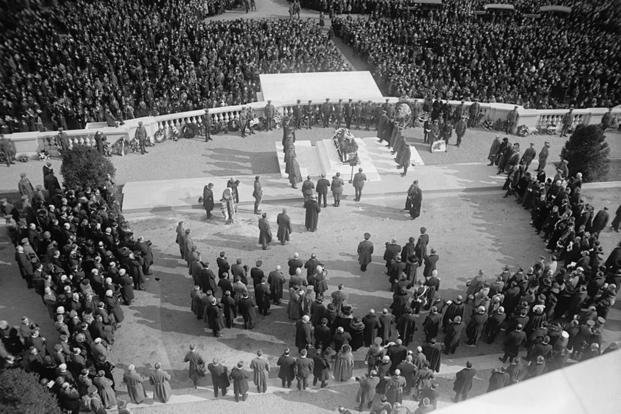
Thursday night after work, Gertie and I went up to the Capitol to see the body in state there. We went up about six o'clock, thinking the crowd would not be so large. But at that time the line (four abreast) extended over two blocks, and by the time we had reached the Capitol steps and could look back at the crowd, it extended up one side of the park, down another side, then the third side of it and on beyond around the Capitol building where we could see no farther, so I don't know how much longer it was. It was perfectly beautifully managed, and there was no crowding, and everyone, strangely enough, acted as though they really were there to pay respect to the memory which that body was to represent to the country, and not there to see out of curiosity.
There were guards, of course, all up the line and then a special guard of honor around the catafalque. The flowers were simply magnificent, each state and then different organizations sent wreaths or flowers made up in some beautiful piece. President Harding's wreath of red roses was on the bier and also a white ribbon was draped over it, which Mrs. Harding had made. It was most impressive, all told.
Friday bright and early, we arose and went down on Pennsylvania Avenue to see the funeral procession. Of course, we had hysterics over Clara trying to wedge us in amidst the crowd. I'll have to leave the details of that to tell. Something on the order of Inauguration, however. It was sort of a fitting setting all around for it, because you remember I told you the day the Olympia arrived with the body, it was very rainy and dark, and in my mind sort of typified the thing itself. Then Friday, when the procession started, it was as though it were in the "gray dawn," for the sun didn't really break through until it was about all passed. And that went with that part of it, too, to me.
There were represented in the procession about every branch of service, and all the organizations, etc. President Harding and the cabinet and the Senate all walked, and we had a chance to see them all very clearly. Only I missed finding Taft until he was passed. I am going to have to see him soon, somehow. It seems that because I am especially anxious to see him, I always miss him!
Did you know that this was the first time in History that three Presidents were seen in the same procession? Wilson had to ride, of course. He looked quite well, and people that have seen him recently seem to think he is much improved. I couldn't quite understand, however, why Mrs. Wilson had to ride by his side, for she was the only lady of that sort in it. The President and cabinet etc. dropped out at the White House and rode up to Arlington. The rest marched on. We didn't attempt to go there because there was no chance of seeing anything and we figured we could read the speech. We had seen the cemetery on Wednesday and knew about what would take place. I'm glad we didn't attempt it for most people were about five hours in all getting up and back.
Then that night was the illumination of the jeweled arch. It was wonderful! When the lights first started to come on, you could see the different lines of the search lights gradually cross each other, and then finally shine out in the most beautiful colors you have ever seen. They fired twenty-one minute guns and the lights were seen through the smoke. I just can't describe to you the effect of it all.
I declare the arch was something that you cannot conceive of man making, somehow. It seemed almost superhuman. The pillars on either side of the street were made into monument effects, the tops from about half way up being covered with sequents [sic] of some sort. This all was on a larger base, and around them, on each base, was a large eagle, and incense bowls all around too, burning. In the center of the arch was a large circle composed of smaller circles, and within each of these the picture of the various flags. Then hanging from the pillars was a straight band of vari-colored glass, I guess it must have been, which positively sparkled with more beautiful colors than I have ever seen. They threw different colored search lights on it from all sides. And that wasn't all -- the Washington monument was lighted so that it looked as though there were streamers of white light from the top to the bottom, and two search lights from the top crossed and were sent out over the city. Also lights were thrown from the Capitol building so far away which were visible, too.
All along the street in front of the Pan American building where the Conference will be held for the most part, there were erected tall poles with Eagles on the top and colored, lighted box effects built about them of the different shields, that is, "flag productions" of the shields. It made the whole street lighter than day, of course, and with all the various colors it certainly was a vision to behold! Course, you will see it in the movies, and maybe not recognize my description of it all, but it's the best I can do, and I thought perhaps Mother and Dad, at least, would like to hear my own description of it!
Yours,
Daughter, Sister and sweetheart.
M
(As a postscript, Mimi wrote:)
Give my love to Grandpa. Sorry he isn't feeling up to par. Tell him to be a good boy. Tell him too that some of his old "cronies" marched to Arlington Friday and they looked mighty fine, I'll tell you -- and I thought a lot about what he did for his country.
The Veterans Day National Committee thanks Ms. Barbara Felt, the author's niece, for sharing this letter to relatives written by her Aunt Mimi.
This letter originally appeared on www.va.gov.
Want to Learn More About Military Life?
Whether you're thinking of joining the military, looking for fitness and basic training tips, or keeping up with military life and benefits, Military.com has you covered. Subscribe to Military.com to have military news, updates and resources delivered directly to your inbox.
